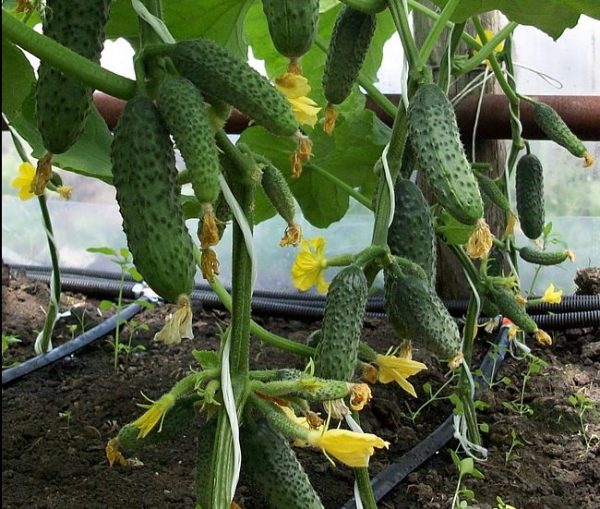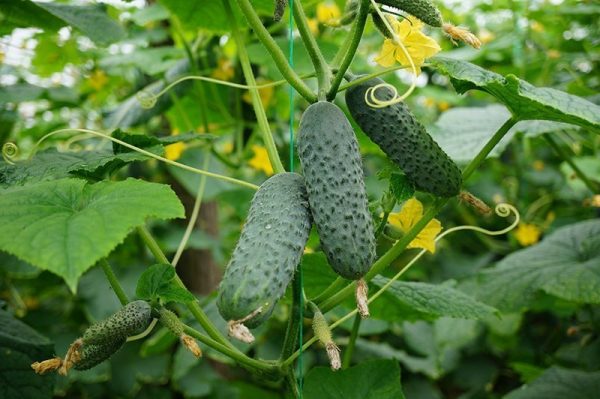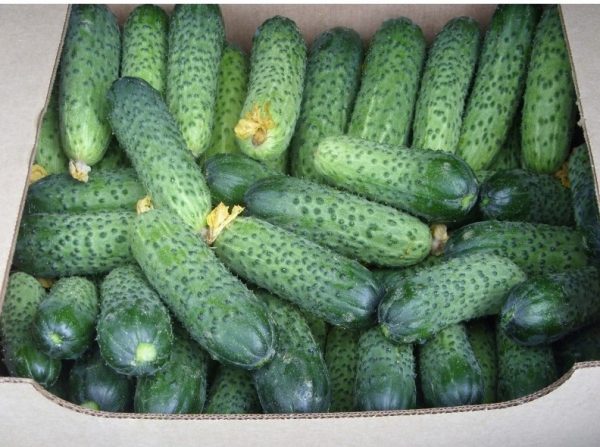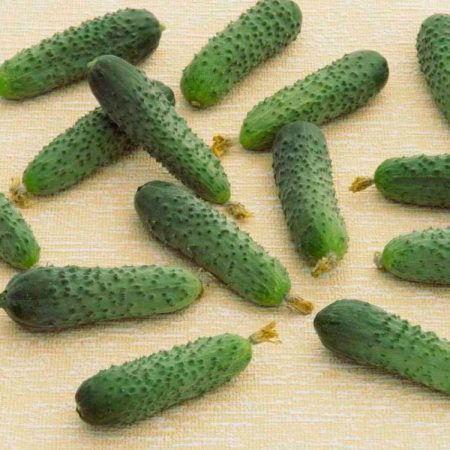This review will be of interest to gardeners who want to try growing Meringue F1 cucumbers. The article provides a description and characteristics of the variety, its advantages and disadvantages. We have collected reviews from summer residents who are already planting Meringue in their greenhouses and open beds.
In this video, see what kind of harvest you can expect when growing this hybrid indoors.
Description and photo of Meringue cucumbers
Meringue F1 is a parthenocarpic hybrid that does not require pollination at all. It can be grown not only in greenhouses, but also indoors. It has a bouquet formation of ovaries - from 1 to 4 fruits can grow in each axil and there are practically no barren flowers.

Each “bouquet” can contain from 1 to 4 cucumbers
It can be grown in greenhouses and in open beds, but when grown indoors the yield is noticeably higher.
Sowing seeds for seedlings - end of April. Planting plants in open ground in late May - early June. Planting scheme in open ground with horizontal cultivation 30x70 cm. In greenhouses on trellises 40x40 cm.

When grown on trellises, denser planting is allowed.
It takes an average of 40 days from germination to technical ripeness of the fruit. The plant grows in one stem and each can grow up to 40-50 fruits, with a total weight of 4-5 kg. However, productivity is highly dependent on the quality of care.

The fruits have an excellent presentation and are stored for a long time
The cucumbers are aligned, cylindrical in shape, 10-12 cm long and weighing about 100 grams. They have no bitterness at all, are crispy, very tasty and do not lose their properties when canned. They retain their marketable appearance for a long time, which is especially popular with farmers who sell them at the market. Here is one of the reviews:
Ksyusha Russia Kuban
A little about my experience. For several years only Meringue was planted. This year, a third of the greenhouse was planted by the Bettinas (very praised). The result is this: Bettina turned out to be twice as productive as Meringue, but there is one BUT!!! - appearance. In the evening, as soon as you pick Bettina, it’s still nothing, in the morning you open it at the market... And the Meringue is beautiful!
Meringue cucumbers are resistant to powdery mildew, olive spot, and relatively resistant to downy mildew and root rot.
Description and characteristics of Meringue and Masha cucumbers
Advantages of the variety
- Precocity
- High yield
- Does not require pollinators, which means it can be grown in greenhouses even in winter
- The variety is resistant to temperature changes and lack of moisture
- Fruits are set in 2-3 pieces in each axil
- Continuous fruiting and absence of empty flowers
- Cucumbers are approximately the same size and weight, never overripe
- Zelentsy does not taste bitter even in the hot summer
- Excellent presentation and the ability to transport without loss of quality
- The hybrid is resistant to major diseases of pumpkin crops
So gardeners confirm these qualities:
Valentina Sergeevna Saratov
I always plant several varieties of Capra, Athena, Meringue, Dellina, but I pick the first cucumbers from Meringue.
Alexander Smolensk
My wife and I have been growing Meringue for several years for sale. Cucumbers have an excellent presentation and tolerate transportation and storage well. A very good variety for sale.
Avid Summer Resident
Our whole family loves this variety. Meringue F1 cucumbers are tasty, crispy and absolutely not bitter. We grow them outside in open beds and always with cucumbers.
The variety has far fewer disadvantages
- The main and perhaps the only drawback is the inability to collect seeds. Every year you have to buy new ones, and they are not cheap at all.
- In open beds the yield is much lower than in greenhouses.
However, not everyone likes this variety:
Good evening everyone! I’ve been planting Kibria and Meringue for 2 years...out of 2 varieties I chose Kibria! Firstly, the yield is higher than that of Meringue and the return is earlier!
Reviews from gardeners
Video review of a summer resident who grows Ecole and Meringue in a small greenhouse:
yourko Odessa
Cucumber Masha F1 is of course very good, but alas. Now there is Meringue F1.
Tamara Ramensky district
During the summer, every 3-4 weeks I plant 6-8 seeds and my cucumbers grow until frost. Such a conveyor can, of course, be organized with other varieties, but I plant Meringue all the time.
Yannochka
This was my first time planting this variety. And he pleased me, one might even say surprised me. All the cucumbers are smooth, appetizing, without any seeds or squiggles. And the taste is no different from ordinary bee-pollinated cucumbers.
Maria Sokolova
“I like to grow cucumbers in winter, so this year (in January) I sowed the Meringue F1 hybrid in my winter greenhouse. The earth only warmed up to 15 degrees, 87 seeds sprouted from 100. The first cucumbers were collected on the 52nd day after emergence. I liked that the cucumbers did not hurt in any way and tasted like German F1. In general, I recommend this variety not only for summer, but also for winter - it’s been tested - they grow even without fertilizing!”
I have been planting meringue cucumbers for years and always get a good harvest. True, I plant in open ground, but I haven’t tried it in a greenhouse. But I think the result will not be much different.
You might be interested in:
- How to properly grow cucumbers in open ground
- How to care for cucumbers in open ground and greenhouses
- How to get rid of spider mites on cucumbers
- Why are cucumbers grown in bags?
- All articles about growing cucumbers



 CUCUMBERS NEVER GET SICK, I'VE BEEN USING ONLY THIS FOR 40 YEARS! I SHARE A SECRET WITH YOU, CUCUMBERS ARE LIKE THE PICTURE!
CUCUMBERS NEVER GET SICK, I'VE BEEN USING ONLY THIS FOR 40 YEARS! I SHARE A SECRET WITH YOU, CUCUMBERS ARE LIKE THE PICTURE! You can dig a bucket of potatoes from each bush. Do you think these are fairy tales? Watch the video
You can dig a bucket of potatoes from each bush. Do you think these are fairy tales? Watch the video
 How our fellow gardeners work in Korea. There is a lot to learn and just fun to watch.
How our fellow gardeners work in Korea. There is a lot to learn and just fun to watch. Eye trainer. The author claims that with daily viewing, vision is restored. They don't charge money for views.
Eye trainer. The author claims that with daily viewing, vision is restored. They don't charge money for views. A 3-ingredient cake recipe in 30 minutes is better than Napoleon. Simple and very tasty.
A 3-ingredient cake recipe in 30 minutes is better than Napoleon. Simple and very tasty. Therapeutic exercises for cervical osteochondrosis. A complete set of exercises.
Therapeutic exercises for cervical osteochondrosis. A complete set of exercises. Which indoor plants match your zodiac sign?
Which indoor plants match your zodiac sign? What about them? Excursion to German dachas.
What about them? Excursion to German dachas.
Good variety. I can’t say it’s the best, but you won’t regret it if you plant it.
For sale on the market, that's it. Exactly all as one.
Yes, good variety